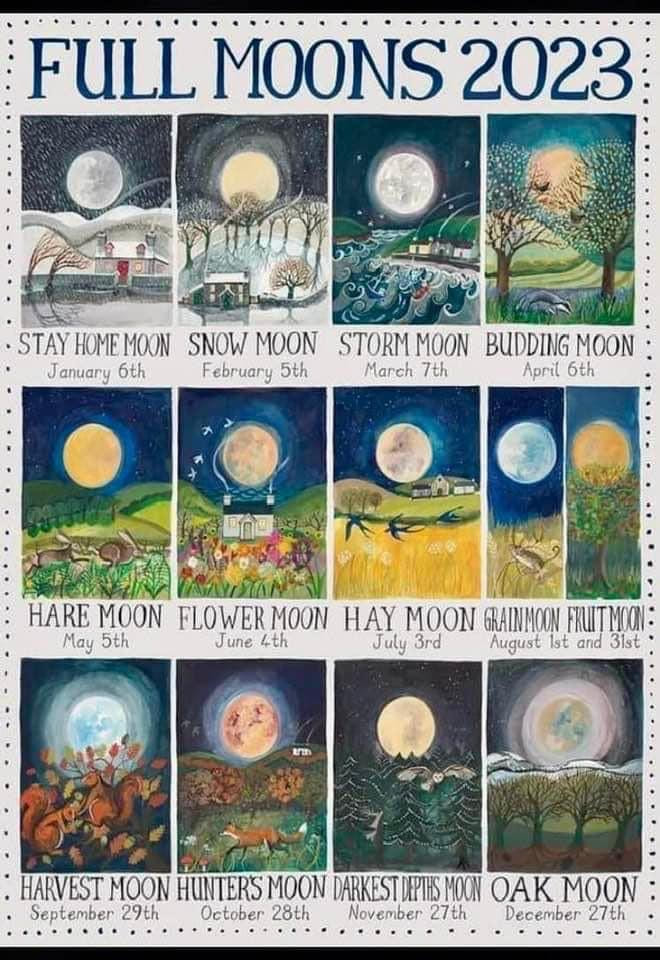|
"Humankind has not woven the web of life. We are but one thread within it.
Whatever we do to the web, we do to ourselves." ~ Chief Seattle 1854 American Indian Tribes gave names to each of the full moons to keep track of the passing year. The names are associated with the entire month until the next full moon occurs. Since a lunar month averages 29 days, the dates of the moons change from year to year. Full Wolf Moon (Great Spirit Moon) January 6, 2023 (6:08 p.m. EST)In January (or the first full Moon after the winter solstice), it’s easy to picture packs of wolves howling at the Moon outside the villages in Europe and North America, as the winter’s rigors deprived the animals of food. Full Snow Moon (Sucker Fish Moon) February 5, 2023 (1:29 p.m. EST)The second full Moon of the year. The winter is still alive and well and the snow covers everything. The Ojibwe named this Moon after the sucker fish, an important resource for their winter survival. Full Worm Moon (Hard Crust on the Snow Moon) March 7, 2023 (7:40 a.m. EST)As the temperatures begin to rise, the snow melts and the earth softens and becomes mud. Worms begin to crawl in the ground, heralding the return of birds, which will feed on them. Also called the Sap Moon, because it’s the time to tap the maples for their sap. Full Pink Moon (Maple Sap Boiling Moon) April 6, 2023 (12:35 a.m. EDT)Attributed to the growth and blossom of the moss pink. Other names for this season make reference to flowers, eggs, fish, and the return of spring. Full Flower Moon (Budding Moon) May 5, 2023 (1:34 p.m. EDT)In May, spring is typically in full force, and various Moon names recognize the budding and blooming of flowers. Other names for this Moon make reference to the period when corn should be planted. Full Strawberry Moon June 3, 2023 (11:42 p.m. EDT)Strawberries are ripe and ready to be picked. The Ojibwe and many other tribes use the same name for this Moon. This month promises a feast on easy food provided by Mother Nature. Full Buck Moon (Mid-summer Moon) July 3, 2023 (7:39 a.m. EDT)Buck’s antlers are growing at full force during this Moon. Also called Thunder Moon because thunderstorms are common during this time of the year. Full Sturgeon Moon (Ricing Moon) August 1, 2023 (2:32 p.m. EDT)The sturgeon fish catch will peak during this moon. For the Ojibwe, this Moon marked the season to harvest wild rice, an activity with cultural and ritual importance. Blue Moon August 30, 2023 (9:36 p.m. EDT)In a year with 13 full Moons, one of them is dubbed a blue Moon. See below for more on two ways to define blue Moons, but note that this particular full Moon is "blue" by either definition. (While this name is not Native American, it is included here for completeness.) Full Corn Moon (Leaves Changing Color Moon) September 29, 2023 (5:58 a.m. EDT)Also called Harvest of Fruit Moon, this is the Moon nearest to the autumnal equinox and can happen in October or September. At this time of the year, the fall crops are ready to be harvested. Full Hunter’s Moon (Falling Leaves Moon) October 28, 2023 (12:24 p.m. EDT)This is the best time of the year for hunting. The game is fat after a summer of eating and fattening for the winter. Many trees have lost their leaves and the fields are free of the crops that might have served as a hideout for prey. Also, it’s the right time to start storing food and furs for the winter. Full Beaver Moon (Freezing Moon) November 27, 2023 (5:16 a.m. EDT)This month’s Moon makes reference to the right moment to hunt beavers for their furs for the winter. Full Cold Moon (Little Spirits Moon) December 26, 2023 (8:33 p.m. EDT)In December, the cold returns and the closes the cycle. The long nights bring back the snow and it’s time to gather by the fire.
0 Comments
Leave a Reply. |
Archives
May 2024
Categories |



